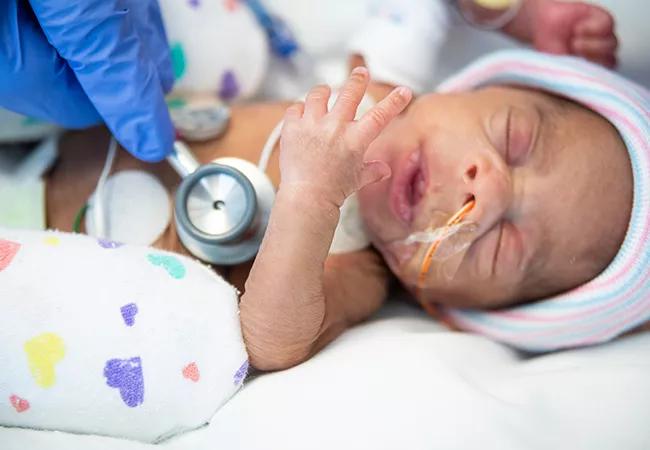Is it time to innovate?

By Anirudha Das, MD, MPH, FAAP
Advertisement
Cleveland Clinic is a non-profit academic medical center. Advertising on our site helps support our mission. We do not endorse non-Cleveland Clinic products or services. Policy
While most newborn infants do not require resuscitation — about 10% of them do — and about 1% of them require intensive resuscitation to restore cardiorespiratory functions. Increased heart rate is an indicator of effective ventilation and response to resuscitation efforts.1 Electrocardiography is currently the recommended tool to assess heart rate during neonatal resuscitation, however, placement on a newborn infant can be difficult and delay heart rate determination.
The aim of our recent study, published in the American Journal of Perinatology, was to compare a new method of heartbeat assessment, the digital stethoscope with loudspeaker amplification to those of traditional stethoscope and electrocardiographic methods.2
During neonatal resuscitation, soon after birth, one provider is responsible for auscultating the heart rate using a stethoscope and communicating it to the other team members. Less often, chest leads, wired to a monitor, are used to monitor heart rate of newborns. The heart rate (low or high) is the primary factor that guides which intervention is needed in neonatal resuscitation. However, delayed or inaccurate determination of heart rate (in beats per minute) could jeopardize efficient resuscitation efforts, putting the newborn at risk for adverse events.
The reliability of current methods of heart rate determination, such as auscultation, umbilical cord palpation and electrocardiography, is debatable. The traditional stethoscope has the disadvantage of the heartbeats being auscultated by a single provider who intermittently announces it to the other resuscitation team members for documentation and need for intervention. The chest leads are often difficult to place on a baby with vernix on their skin and can delay the initial heart rate determination. However, digital stethoscopes have been growing in popularity in pediatric and adult medicine and could play an important role in determining timely, accurate heart rate in the newborn population.
Advertisement
In our simulation-based study, a high-fidelity manikin’s heart rate, respiration and pulse oximetry were controlled wirelessly by a designated person (manikin controller). The controller complied with the instructions associated with three scenarios provided to the teams and changed the settings of the vitals of the manikin during the resuscitation, noting the timing of the change in vitals. The timings were then compared to the actual code sheet to gather relevant data for the study.
Six teams, each composed of three NICU healthcare providers, performed simulated neonatal resuscitation three times each using the three different methods of heart rate determination: the traditional stethoscope used by a single provider, chest leads with electrocardiogram and the digital stethoscope wirelessly connected to a speaker, amplifying the heart sounds. The order of the three scenarios were changed for each team.
The amplified heart rate during resuscitation in a simulated setting significantly improved the number of heart rates documented on the code sheet, reduced the time to first heart rate recording and the number of missed or delayed heart rate assessments, and reduced the time to recognition of heart rate changes. The use of a digital stethoscope with loudspeaker amplification also improved the accuracy and speed of heart rate assessment during neonatal resuscitation. The technology allowed for clear and amplified heart sounds to be heard by all participating providers, which improved communication and collaboration among the team. The loudspeaker amplification also allowed for the heart sounds to be heard over background noise, which is often present in a clinical setting.
Advertisement
Limited research regarding the use of digital stethoscopes in neonatal resuscitation has shown it to be as accurate but faster in data acquisition compared to electrocardiography.3 To the best of our knowledge, our study is the first to use a digital sound amplification system for neonatal resuscitation. Controlling the heart rate using a high-fidelity manikin in a simulation setting is the only way to assess for the accuracy and speed of recognition of heart rate by providers and comparing different methods. The major advantage of our method was giving the ability for all resuscitation team members to be aware of the heart rate of the infant from the beginning, which made documentation and preparing for the next intervention by the team more efficient.
Although in a simulated setting, this experiment proves that a simple setup of a digital stethoscope connected wirelessly to a Bluetooth speaker could overcome the disadvantages of currently used methods for heart rate determination during neonatal resuscitation. We plan to apply for a grant to conduct a human subject research to apply this technology in a clinical setting and evaluate its effectiveness while gathering user feedback.
About the author: Dr. Das is staff in Cleveland Clinic Children’s Department of Neonatology.
References
Advertisement
Advertisement

Quality improvement project addresses unplanned extubation

National database study reveals insights into survival outcomes

Following an international call for proposals, experts ranked the following proposals

Specialized clinic provides comprehensive care for pediatric patients with a high-risk history

Target levels of oxygen saturation might only be achieved around one-third of the day, according to available literature

Levels of volatile organic compounds differ between preterm and full-term infants

Home weight monitoring in healthy newborn infants is feasible

Study underscores the magnitude of stroke in pediatric ECMO patients